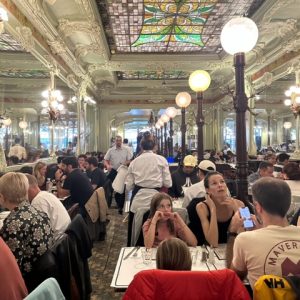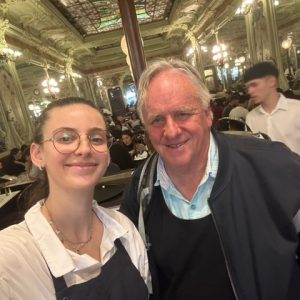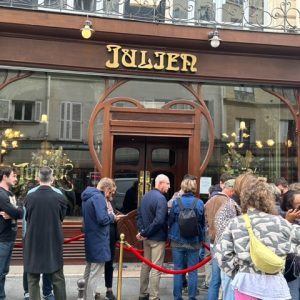Bouillon Julien
Bouillon Julien is a stunningly beautiful restaurant, which is worth a visit, if only for its architecture and design. Indeed, it is one of the most beautiful restaurants in Paris, if not the world. It remains one of the best preserved examples of the Art Nouveau style.
Over the years, it has been the favoured haunt of many well-known cultural figures. Edith Piaf and her lover, Marcel Cerdan, the champion boxer, would frequently dine at ‘table n. 24’.
The building was constructed in 1906 by the French architect Edouard Fournier and was decorated by a number of exceptional artisans working in the Art Nouveau style. Armand Segaud created the peacock panels, while the mahogany bar is attributed to famed ‘Ecole de Nancy’ woodworker Louis Majorelle.
The master glassmaker Louis Trezel, inspired by the iconography of Alfons Mucha created 4 magnificent “flower women”. These nymphs, symbolizing the four seasons, are individually represented in four glass panels facing each other. The ceramist Hippolyte Boulenger designed the patterns of the tiles, a veritable carpet of flowers, with its combination of geraniums and daisies.
Charles Buffet (the father of the famous Bernard) made the drawings for the glass roof, the creation of which was entrusted to Georges Guenne, a specialist in artistic stained glass, conveniently a resident of the neighborhood. Louis Majorelle, one of the most famous cabinetmakers of the Nancy School was responsible for the furniture, including the spectacular Cuban mahogany bar covered in tin, still in use a century later!
In 2018, the Guild of Saint Luke, led by British designer John Whelan undertook the renovation of Bouillon Julien, with the sole aim of seeking authenticity. During the initial research phase, they made a fascinating discovery: a stratigraphy of the painting revealed that the original color of the walls, which everyone imagined as beige, was in fact a “Céladon” green. The Bouillon Julien is now completely repainted in this emblematic color of the Art Nouveau movement. All the ornaments find their meaning and coherence.
Despite having operated as a brasserie for many years, Julien was created as a ‘bouillon’ in 1906. In 2018, it reverted to being a ‘bouillon’ once more.
A ‘bouillon’ is a restaurant first created in the late 19th and early 20th centuries serving traditional French cuisine, in particular a ‘bouillon’ (broth). The particularity of the ‘bouillon’ was to serve good quality food at affordable prices. In 1900, nearly two hundred and fifty broths could be found in Paris. Today, Julien claims to be one of only a small handful of authentic restaurants of this kind that remain in the French capital.
Today, the reality of Julien is that its prices are indeed very affordable. But the quality of the food is very ordinary.
I ordered the following. For entree, Melon segments and raw ham chiffonade – the ham was tasteless little chopped up pieces. For the main course, Pan-fried Butcher’s Piece, with Pepper Sauce and Fresh French Fries – it did not receive the pepper sauce, and the meat was tough. And the Pavlova for dessert was a poor imitation of the real Australian recipe.
What’s the problem with Julien? French restaurants are at their best when they are run by a devoted family, or a proud and dedicated chef. But today, Julien is part of a corporate chain – The Grandes Brasseries de l’Est – probably run by accountants and lawyers, who only care about profits.
On that count, Julien is probably very successful. It is full of international tourists and French people after a cheap thrill.
Please go to Julien for the extraordinary architecture and design. But don’t count on your visit being a gastronomical experience!





